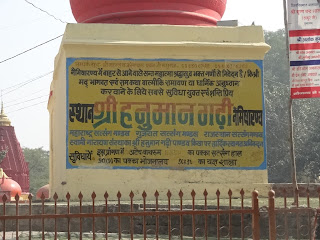Hanuman garhi in Naimisharanya: Ahiravan (the younger brother of Ravan) had captured Ramchandraji and Lakshman in Lanka and taken them to paatal (the nether regions). Hanuman saved them and carried them out, at this place. The murti of Hanumanji here is huge - say about 15 feet high and is in a standing pose. There is also a small murti of Makardhwaj - son of Hanuman, born of his perspiration (which fell into the mouth of a fish), when returning from Lanka. Incidentally, we also have two other Hanuman garhi - one in Allahabad (which has a lying down pose) and another in Ayodhya.
As mentioned in an earlier post, Ved Vyas wrote the 18 Maha Purans, the Mahabharat besides compiling the four Veds. His disciple Lomaharshan passed on this knowledge to his son Ugrashrav (उग्रश्रव), also known as Sut ji Naimisharanya has the Sut gaddi (seat of Sut) where Sut ji narrated all the purans to the 88,000 rishis - Shaunak and other rishis - generally referred to as Shaunakadi or Shaunak etc.
 |
Naimisharanya which finds a mention perhaps in all the Purans, also has a small temple dedicated to the five Pandavs who had passed by here.
Mishrikh : This place is some distance away and requires a small detour on the Lucknow Road. Here rishi Dadichi donated his bones. As per Brahma Vaivart Puran, the gods once fought with the demons and managed to defeat them. After the war rishi Dadhichi agreed to keep their weapons in his ashram (considered a safe place). The weapons began to lose their luster with time, Dadhichi washed them, drank the water and so absorbed their energy; the weapons gradually faded away. When the gods finally came to claim their weapons Dadhichi offered his bones for making weapons. Before that, he took a dip in the kund which was a collection of holy waters from several pilgrimage sites. This spot has got its name from ‘mishrith’ meaning mixed.
 |
Mishrisk - the kund has holy waters from all
teerths
|
The weapons made were Arjun’s Gandiv, the ‘Pinak’ which Ramji broke at Sita’s swayamvar, the ‘Sharang’ which is with Vishnu ji, and the fourth ‘Vajra’ with Indra.
 |
The story of Dadhichi
|
 |
The story of Dadhichi and his sacrifice
|
This is the fourth and final post on Naimisharanya.
















